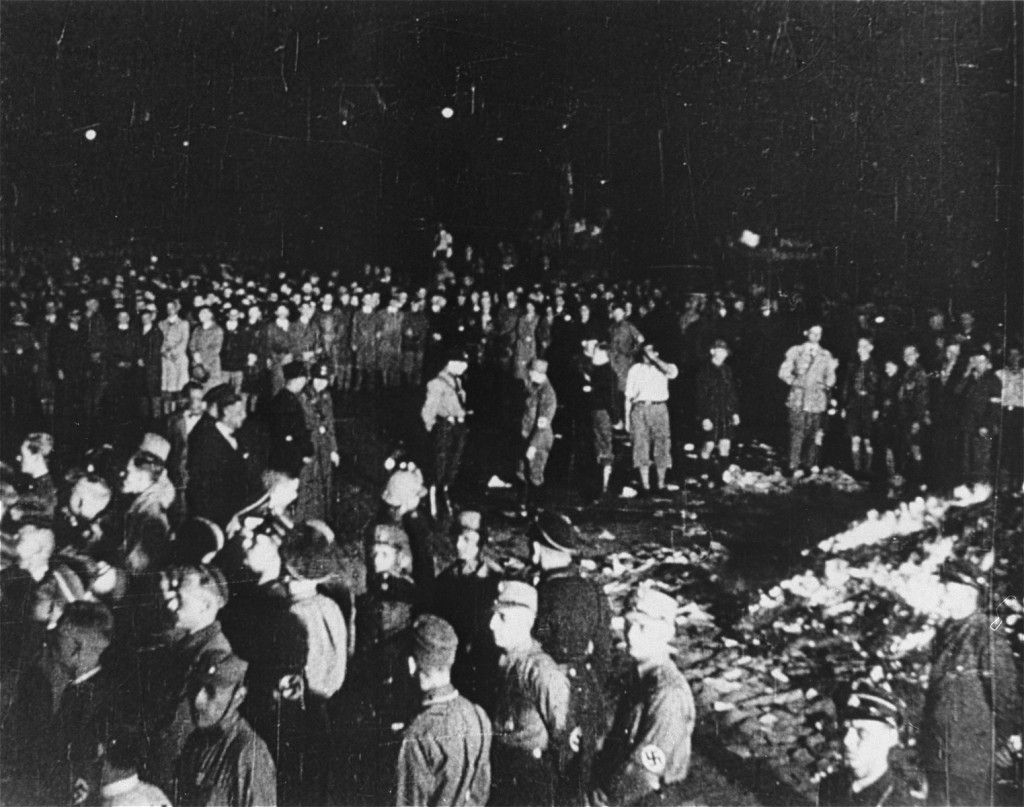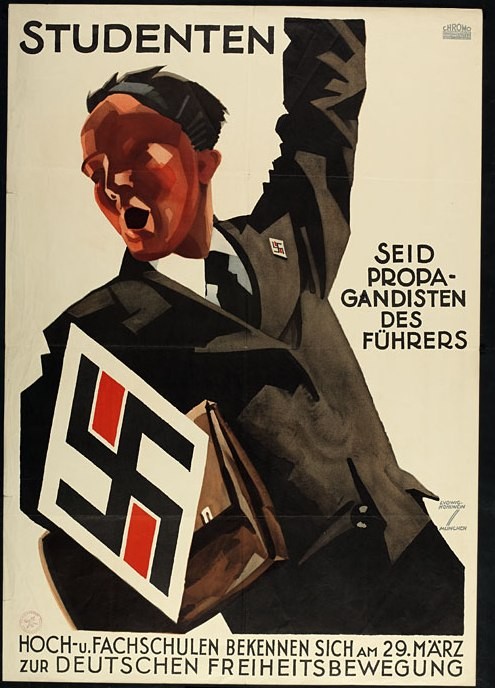University Student Groups in Nazi Germany
Nazi student groups played a key role in aligning German universities with Nazi ideology and in solidifying Nazi power.
The National Socialist German Students' League
In 1926 the Nazi Party founded the National Socialist German Students' League (Nationalsozialistischer Deutscher Studentenbund). The league was to foster ideological training at universities and to implement paramilitary training disguised as exercise and work details. The ideal Nazi student was intended to be a man or woman of action, not an idle thinker. Nazi campaign posters from 1932 appealed especially to male students as one of the two pillars of the burgeoning movement: “Workers of the Head and the Fist [Arbeiter der Stirn und der Faust].”
Responding to this call, members of the National Socialist German Students' League distinguished themselves by wearing brown shirts and by living together in association houses (Kameradschaftshäuser), mimicking the traditions of German all-male student fraternity groups (Burschenschaften). These fraternities had long ranked among the most nationalistic and antisemitic elements of German society. Their members embraced National Socialism in disproportionately high numbers. However, members of the fraternities saw themselves as social elites. They were often at odds with the tactics of street politics employed by the Nazi Students' League, even while embracing the party’s agenda. These overlapping interests along with territorial disagreements created a turbulent atmosphere of feuding rivalries among student groups in early 1933.
Violence and Intimidation
The passage of the “Law for the Restoration of the Professional Civil Service” on April 7, 1933, propelled the Students' League to the forefront of university politics, elevating it from the status of a fringe organization. The law mandated the dismissal of all tenured German civil servants who were “not of Aryan descent," as well as “political opponents” of the regime. In the university context, the law authorized the release of Jewish and “politically undesirable” faculty members from service. Exceptions were those who had served on the front in World War I or were appointed before the beginning of the Weimar Republic. This action resulted in the removal of over 1,100 faculty members from service by 1935. It emboldened radical student groups to employ violence and intimidation against students and faculty members.
The more brazen groups used the resulting atmosphere of denunciations and threats to act on their antisemitic sentiments. They also carried out grudges against students and instructors. The National Socialist German Students' League directly targeted Jewish students and the remaining Jewish faculty members.
The Students' League’s actions took many different forms. Paramilitary student groups often interrupted lectures, provoked skirmishes, and physically intimidated Jewish students in actions tolerated by university administrations and encouraged by the Nazi Party. For example,
- In Freiburg, the local chapter of the Students' League ransacked and occupied the house of the Jewish Fraternity Neo-Friburgia in May 1933.
- In Heidelberg, a student-led denunciation campaign targeting the Jewish eugenicist Heinrich Poll was motivated by student resentment over his strict grading practices.
- In Dresden, Erlangen, Königsberg, Münster and Rostock, the Students' League erected ‘shaming posts’ to display the writings of ‘un-German’ professors.

These actions culminated in the student-led book burnings on May 10, 1933, as an orchestrated campaign against “un-German” texts and authors.
Nazi student groups formed the most powerful entity at many universities from approximately April to July 1933. In some cases, aggressive Students' League leaders subordinated the university administration to their violent tactics. This was the case in Heidelberg with student leader Gustav Adolf Scheel.
By the summer of 1933, the Nazi Party had achieved many of its revolutionary goals for the remaking of universities. The party began to rein in student groups and restore the balance of power at German universities to the full professors (Ordinarien).
Nazification of Student Governance

In 1934 the Students' League assumed control over the previously independent Student Union (Studentenschaft), the official nationwide body of student governance. The two groups were united under a single leader. This action effectively Nazified all forms of student governance.
After the "synchronization" of university faculty and curriculum in 1933–34, German professors gained back from the student groups a significant degree of autonomy over universities by 1935. At the same time, the fraternities resisted the Students' League’s plan to forcefully integrate fraternity houses into a network of Nazi association houses in which residency would be mandatory for all male students. The fraternities were often represented by powerful interests.
The number of female students rose progressively in Nazi Germany. They were represented by the Labor Association of National Socialist Female Students (Arbeitsgemeinschaft nationalsozialistischer Studentinnen). This association which arranged for mandatory work and ideological training, often in agricultural settings.
In 1936 Hitler appointed Gustav Adolf Scheel as Reichsstudentenführer in an attempt to suppress rivalries between the Student Union and Students' League. Scheel struggled to replicate the success of 1933 as many students objected to the militarization and regimentation of their lives. They especially objected to the mandatory physical training and work details. Students who ran into conflict with their local Students' League often simply moved to a different university. They even engaged in the practice of ‘university-hopping’ from semester to semester in order to escape discipline.
Nazi Student Organizations up to 1945
Nazi student organizations remained an important source of academic surveillance over faculty and other students until 1945. The Students' League frequently denounced professors proactively. The league also served as an important source for the ideological assessments of instructors’ teaching by frequently providing information to agencies such as the Security Service and Alfred Rosenberg’s office for intellectual surveillance.
While the Nazi Party never developed a coherent, centralized politics for universities and student groups, Nazi student groups were essential contributors to the era of synchronization and a significant presence at universities throughout the era of National Socialism.
The Students' League was dissolved and banned by Allied Command in October 1945. The extreme right-wing Kyffhäuserbund was the only fraternity banned by the French occupation authorities in 1945.

